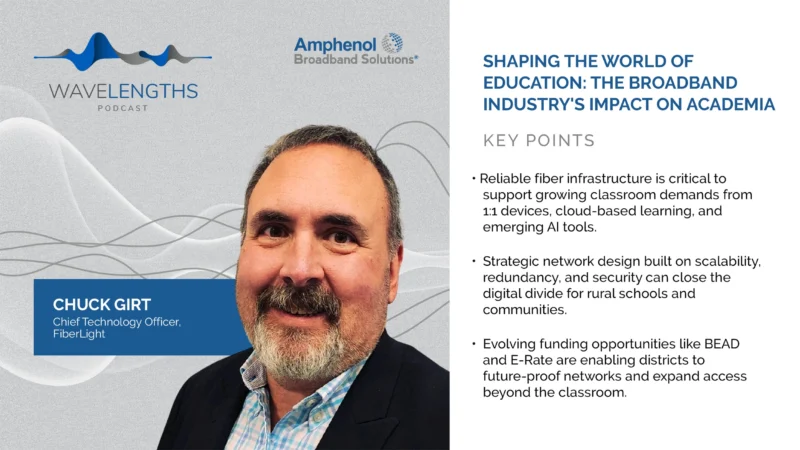Shaping the World of Education: The Broadband Industry’s Impact on Academia, Part 2
In Part 2 of this Wavelengths conversation, host Daniel Litwin continues his discussion with Chuck Girt, Chief Technology Officer at FiberLight, diving deeper into the broader ecosystem of education connectivity.
While Part 1 focused on building resilient networks inside the classroom, this episode looks outward, examining how education networks must extend into homes, public spaces, and communities to truly close the digital divide. Girt shares how funding shifts, cybersecurity challenges, and new technology trends are reshaping how districts think about connectivity beyond school walls.
With decades of experience in telecommunications and education infrastructure, Girt outlines a blueprint for designing networks that support students wherever learning happens, from classrooms to Chromebooks at home to roaming connections in libraries and community centers.
Key Discussion Highlights:
- Extending Learning Beyond School Walls: Girt emphasizes that education doesn’t stop at the classroom door. Reliable fiber must power home connectivity, bus Wi-Fi, and community hotspots to ensure equitable access for all students.
- The Funding Pendulum: The episode explores how shifting definitions of “community anchor institutions” and the push-and-pull of BEAD, E-Rate, and state funding complicate planning—but also create new opportunities for strategic investment.
- Cybersecurity in the Age of AI: With ransomware attacks on schools rising 23% year-over-year, Girt stresses that security must be built into network design, supported by operators, MSPs, and AI-driven defenses that protect students and their data.
- The Eduroam Example: Expanding secure roaming networks for students introduces new benefits—and new risks. Girt explains how smart certificate management and network-wide threat detection can safeguard roaming access.
- Last Mile Upgrades that Matter: From moving content closer to the edge, to modernizing in-building infrastructure, Girt outlines practical, district-level strategies that deliver immediate improvements while waiting for larger-scale rollouts.
- Trends to Watch: Looking ahead, Girt sees AI as the most powerful driver of education connectivity, enabling immersive learning, VR classrooms, and cross-institution collaboration that demands higher bandwidth.
This episode offers practical insights for school district CIOs, administrators, and broadband providers alike. Girt makes clear that future-ready education networks require not just classroom connectivity, but a holistic approach that extends into communities, anticipates cybersecurity threats, and leverages funding to fuel long-term growth.




